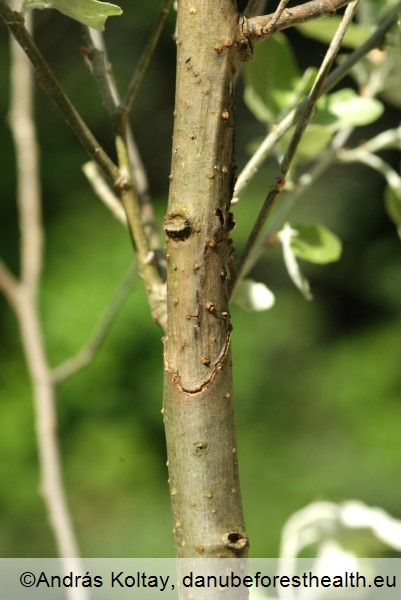Fungi
Dieback and canker of poplars
Botryosphaeriaceae, Dothichiza, Cytospora and other canker diseases
Thomas Cech
|
|

Fig. 1. Necrosis of Cryptodiaporthe populea

Fig. 2. Necrosis of Cryptodiaporthe populea (asexual stage Discosporium populeum)

Fig. 3. Dieback of shoots of poplar showing spore tendril of Cytospora sp.
DETECTION PERIOD:
whole year
DESCRIPTION:
Trees show dieback of twigs, branches and/or stems. Commonly this is associated with distinct necrotic lesions on the bark surface. The lesions are usually sunken brownish areas with a sharp border and of characteristic elliptic-elongated shape. Sometimes there is formation of wound callus, especially if the cankers extend from annual shoots to older twigs and branches resulting in excrescences. In this case the bark also cracks open. In and later around the lesions pustule-shaped blackish fruiting bodies develop (hand-lens!) releasing infectious spores. Cryptodiaporthe populea (Dothichiza-disease of poplars) is the most common species and usually the direct consequence of water deficiency in the living bark (Fig.1). In Italian poplars (Populus nigra 'Italica') infection by C. populea can also be caused by severe frost. In addition, there are genetic differences in sensitivity among poplar clones. Some other fungal species on poplar bark as for instance Cytospora spp., with yellowish spore tendrils emerging from the necrotic bark are often only weakly pathogenic (Fig.2). Cankers caused by Entoleuca mammata show distinct flat black curst-like fruiting-bodies emerging through the bark.
HABITAT:
On poplars in natural habitats, nurseries, plantations and urban areas.
STATUS:
Canker diseases of poplars are ubiquitous in Europe. They are very common in urban areas, but also in riparian forests, here sometimes a consequence of floods and subsequent drought periods resulting in soil-sealing by mud deposition.
IMPACT:
Canker diseases of poplars show a broad spectrum from small-twigs-dieback to stand-wise loss of trees. Especially young plants may die quickly due to infections.
SIMILAR SPECIES:
Scab – caused by species of Venturia results in dieback of leaves and young shoots in spring, with black discoloration of all diseased parts. Bacterial canker of poplars (Xanthomonas populi) somehow show similar symptoms, however the cankers produce mesentery-like structures of the bark surface. Cankers can also be mistaken for galleries of cycads, which deposit their eggs on smooth-barked stems (Cycadella viridis).
|